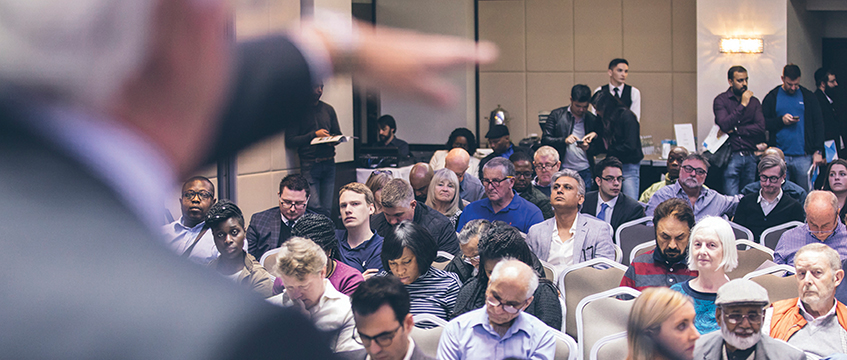There is no denying that the real estate investment market is tough today. It may not be completely static but the world is moving more slowly than it has before.
Click below to listen to the full roundtable with the auction experts:
Investors are cautious and they are pausing for thought. Or at least they are in the private treaty market, but what about in the auctions sector – a sector that is often seen as the coalface of property, a sector that is able to lead the market on where values may be, what asset classes are attractive and which are not?
EG gathered experts from three of the UK’s most active auctioneers to discuss the temperature of the auctions market, what, if anything, was selling well and whether Brexit and the continued uncertainty around it was impacting sales.
For Oliver Childs, head of commercial auctions at BidX1, while the market may be tough, there at least exists a market – as long as the pricing is right.
“There is still a strong core of buyers out there,” agrees Max Mason, head of sales at 574, the new online auctions division of Lambert Smith Hampton, “but there is a need to get the pricing right and to encourage that competitive interest.”
“The great thing about our market,” adds Allsop partner and auctioneer George Walker, “is that the pricing shows a lot of yield and draws in new buyers. And that’s the lifeblood of what we do. There are 20,000 people who regularly look at what we do, but when you have this disparity in pricing, the yield-
hungry buyers are all over it”
“But it isn’t a walk in the park,” he caveats. “The pricing is incredibly inconsistent, particularly for the more difficult assets.”
Commitment counts
What does make for more of a walk in the park, agreed all the auctioneers, was a committed seller – a motivated seller that knows they need to get a deal and that is realistic on where values may be.
Walker cites the work that Allsop is doing for fund manager Columbia Threadneedle. “We’ve been very lucky to work with Threadneedle, which is a very well-known retail investor and very successful fund manager. They’ve been really useful for the market overall in the past 12 months because they have decided there are some assets they want to sell. They’re very realistic. They know that some of these shops are going to be hard to let so they are asking what the market will pay. Because Threadneedle are objective, expert investors, they listen to the market, and that gives us the ability to read the market.”
Columbia Threadneedle hit the headlines earlier this year after putting a £1 reserve on a mostly vacant 81,000 sq ft shopping centre in Kirkcaldy. The low reserve was a test to judge the market for empty tertiary Scottish shopping centres. The mall sold for £310,000 – a 50% yield. That “value” may well have been some way off the millions the vendor paid for the mall several years ago, but it showed that there was still a market. It still sold.

Retail still in demand
Childs believes there still is demand for retail, particularly with value-add potential.
“If you look at some of the neighbourhood locations, whether it be outside the M25 or in some of the stronger regional cities like Manchester, Birmingham and Liverpool, there’s great demand,” he says. “There’s that added-value opportunity, and I think that’s where the pricing is in the auctions market at the moment. That’s what the market wants. It wants value, it wants to add value and it wants asset management.”
Walker says that individual buyers have become a lot more savvy at seeking out that value and how to add it. He said that this was leading to an increase in attractiveness of alternative investments, with NCP-let car parks at Allsop’s most recent commercial auction proving very popular.
“Why would you pay 5% for a car park in Newport in Wales?” he questioned. “It is not a popular town, but the letting mechanics, the financial mechanics of that deal really appealed. There is a great wall of money for yield.”
“We used to think that because people were so random and bullish in auctions,” adds Walker, “they would buy anything. But these buyers are very savvy and we never underestimate them. They will have an understanding for a covenant almost instinctively. They’ve been doing it a long time and it took a whole lot to earn their money – they are not going to give it away.”
When it comes to Brexit, Childs, Walker and Mason all agreed that it was having limited impact on volumes and trading.
“What we’re seeing is that nothing’s really changed in the past 12 months,” says Mason. “That base of buyers is still there, and they have factored in the risks.”
Childs agrees: “Brexit is a bit of an excuse. Ultimately, a lot of people have cash in the bank and they want to spend it. There’s a lack of alternative investment opportunity, and people do like a tangible asset.
“I actually think it’s a positive market at the moment. We’ve got more buyers than we have sellers, and while we’ve got that and we’ve got people who know and understand their local markets, then I think we will have a strong year.”
In partnership with

To send feedback, e-mail samantha.mcclary@egi.co.uk or tweet @samanthamcclary or @estatesgazette











